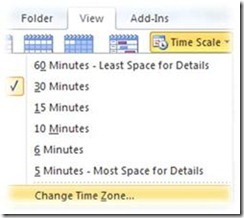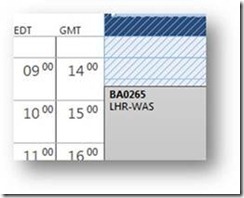Tip o’ the Week #26 – multiple time zones in Outlook Calendar
Sometimes you need to create appointments that will make sense when you’re in a different time zone - it helps to use Outlook, Exchange and its phone integration to put relevant stuff in  the calendar, so you can make sure you’re in the right place and at the right time.
the calendar, so you can make sure you’re in the right place and at the right time.
Now there are a couple of ways to make Outlook more timezone-friendly – if you right-click on the time bar to the left of the calendar detail, then a fly-out menu will let you Change Time Zone. An alternative, can be found in the “Time Scale” option on the View tab when looking at the Calendar. As with many things, there are several ways to skin the proverbial cat…
If you choose to change the time zone, Outlook displays its options dialog, which lets you select the current time zone (and also sets the whole PC into that time zone so you needn’t change the PC clock separately), but helpfully also lets you display a second  zone, and give both a label so you can see which is which…
zone, and give both a label so you can see which is which…
If you edit an appointment, it’s also possible to show multiple time zones, and to set the destination time zone for an appointment to take place. In other words, if I’m arranging to meet someone at 7pm in Washington DC, I don’t need to manually figure out what time that is in the UK, I just set the time zone of the appointment to be Eastern Daylight Time.
 As it happens, Outlook always converts an appointment back to “UTC”* – what we still know as GMT in the UK, is actually the base for all appointments, and then a time offset is applied depending on whether the time zone(s) in question have Daylight Saving Time in effect, etc. So an appointment is never 7pm in Washington DC, it’s actually at 00:00 then -5 is offset, since their time zone is UTC-5.
As it happens, Outlook always converts an appointment back to “UTC”* – what we still know as GMT in the UK, is actually the base for all appointments, and then a time offset is applied depending on whether the time zone(s) in question have Daylight Saving Time in effect, etc. So an appointment is never 7pm in Washington DC, it’s actually at 00:00 then -5 is offset, since their time zone is UTC-5.
It’s even possible to have an appointment which starts and finishes in a different time zone. The only example I can think of this is a flight, but there may be others. Suggestions on a postcard please…
* UTC doesn’t actually stand for anything – the ITU standards body wanted a single worldwide abbreviation; English speakers wanted “Coordinated Universal Time” or CUT. French speakers wanted “temps universel coordonné” or TUC. Unable to separate the two factions, they compromised and chose UTC.
